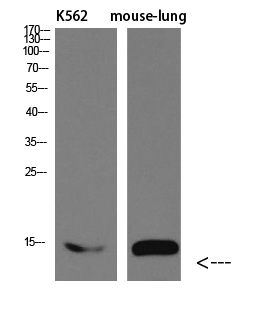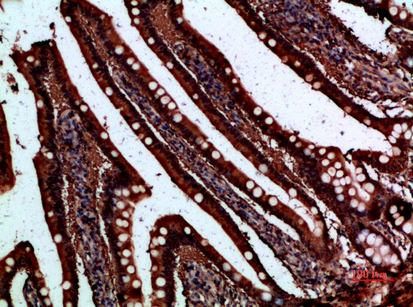产品名称
I-FABP Rabbit Polyclonal Antibody
别名
Fatty acid-binding protein, intestinal (Fatty acid-binding protein 2;Intestinal-type fatty acid-binding protein;I-FABP)
蛋白名称
Fatty acid-binding protein, intestinal (Fatty acid-binding protein 2) (Intestinal-type fatty acid-binding protein) (I-FABP)
存储缓冲液
Liquid in PBS containing 50% glycerol, 0.5% BSA and 0.02% New type preservative N.
Human Gene Link
http://www.ncbi.nlm.nih.gov/sites/entrez?db=gene&term=2169
Human Swissprot No.
P12104
Human Swissprot Link
http://www.uniprot.org/uniprotkb/P12104/entry
Mouse Swissprot No.
P55050
Mouse Swissprot Link
http://www.uniprot.org/uniprot/P55050
Rat Swissprot Link
http://www.uniprot.org/uniprot/O54941P02693
免疫原
Synthetic peptide from human protein at AA range: 90-132
特异性
The antibody detects endogenous I-FABP
稀释度
WB 1:500-2000,IHC-p 1:500-200, ELISA 1:10000-20000. IF 1:50-200
宿主
Polyclonal, Rabbit,IgG
背景介绍
The intracellular fatty acid-binding proteins (FABPs) belong to a multigene family with nearly twenty identified members. FABPs are divided into at least three distinct types, namely the hepatic-, intestinal- and cardiac-type. They form 14-15 kDa proteins and are thought to participate in the uptake, intracellular metabolism and/or transport of long-chain fatty acids. They may also be responsible in the modulation of cell growth and proliferation. Intestinal fatty acid-binding protein 2 gene contains four exons and is an abundant cytosolic protein in small intestine epithelial cells. This gene has a polymorphism at codon 54 that identified an alanine-encoding allele and a threonine-encoding allele. Thr-54 protein is associated with increased fat oxidation and insulin resistance. [provided by RefSeq, Jul 2008],
组织表达
Expressed in the small intestine and at much lower levels in the large intestine. Highest expression levels in the jejunum.
功能
domain:Forms a beta-barrel structure that accommodates the hydrophobic ligand in its interior.,function:FABP are thought to play a role in the intracellular transport of long-chain fatty acids and their acyl-CoA esters. FABP2 is probably involved in triglyceride-rich lipoprotein synthesis. Binds saturated long-chain fatty acids with a high affinity, but binds with a lower affinity to unsaturated long-chain fatty acids. FABP2 may also help maintain energy homeostasis by functioning as a lipid sensor.,induction:By EGF.,similarity:Belongs to the calycin superfamily. Fatty-acid binding protein (FABP) family.,tissue specificity:Expressed in the small intestine and at much lower levels in the large intestine. Highest expression levels in the jejunum.,
纯化
The antibody was affinity-purified from rabbit antiserum by affinity-chromatography using epitope-specific immunogen.



